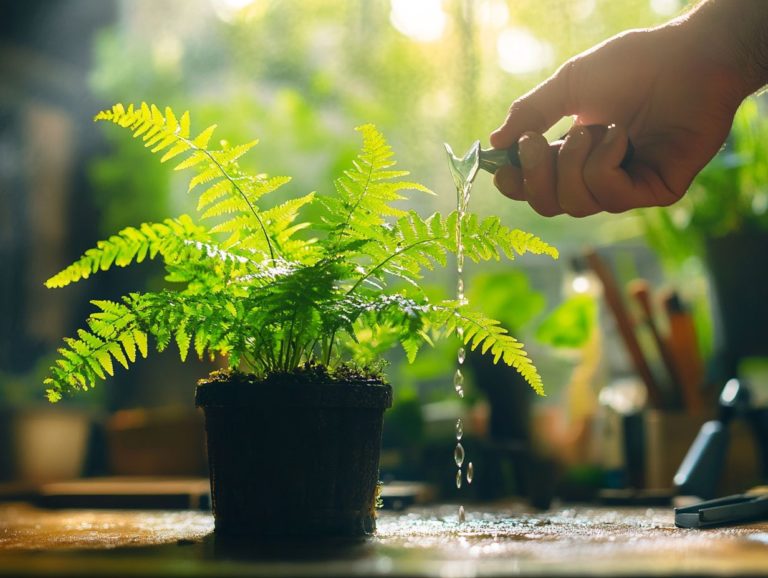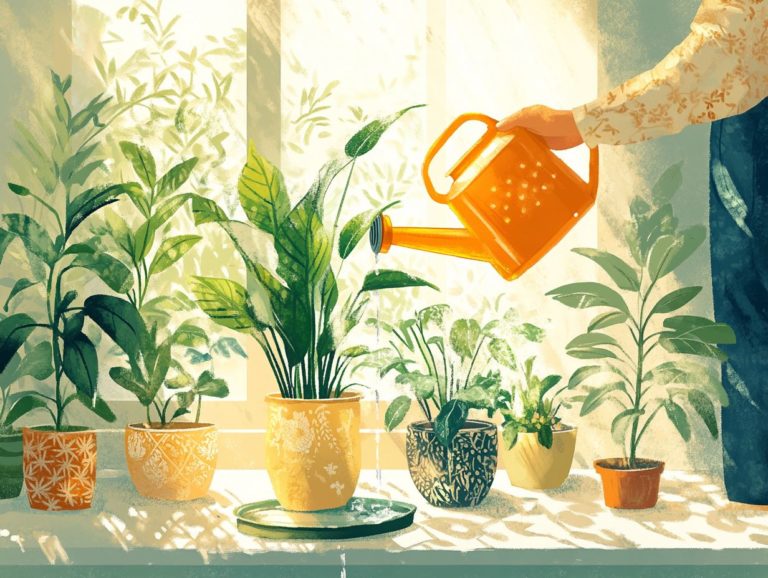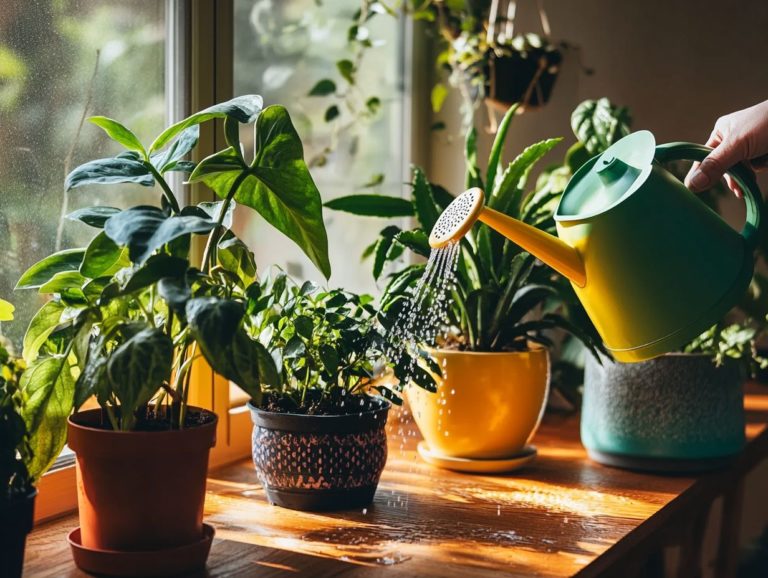How to Water Succulents Correctly
Succulents are captivating plants that bring nature into your space. Understanding their unique watering needs is crucial for maintaining their health.
This guide will unlock the secrets of succulent care, detailing their specific water requirements and helping you identify the signs of under-watering or over-watering.
You ll discover best practices for watering, customized techniques for various containers, and essential factors like temperature and humidity that influence their care.
Immerse yourself in this journey and elevate your succulent expertise!
Contents
- Key Takeaways:
- Understanding Succulents and Their Water Needs
- Signs of Under and Over-Watering Succulents
- Tips for Watering Succulents Correctly
- Watering Techniques for Different Types of Containers
- Other Factors to Consider
- Frequently Asked Questions
- How often should I water my succulents?
- How much water should I give my succulents?
- Can I use tap water to water my succulents?
- Is it better to water my succulents from the top or the bottom?
- How do I know if I am watering my succulents correctly?
- Should I water my succulents during their dormant period?
Key Takeaways:
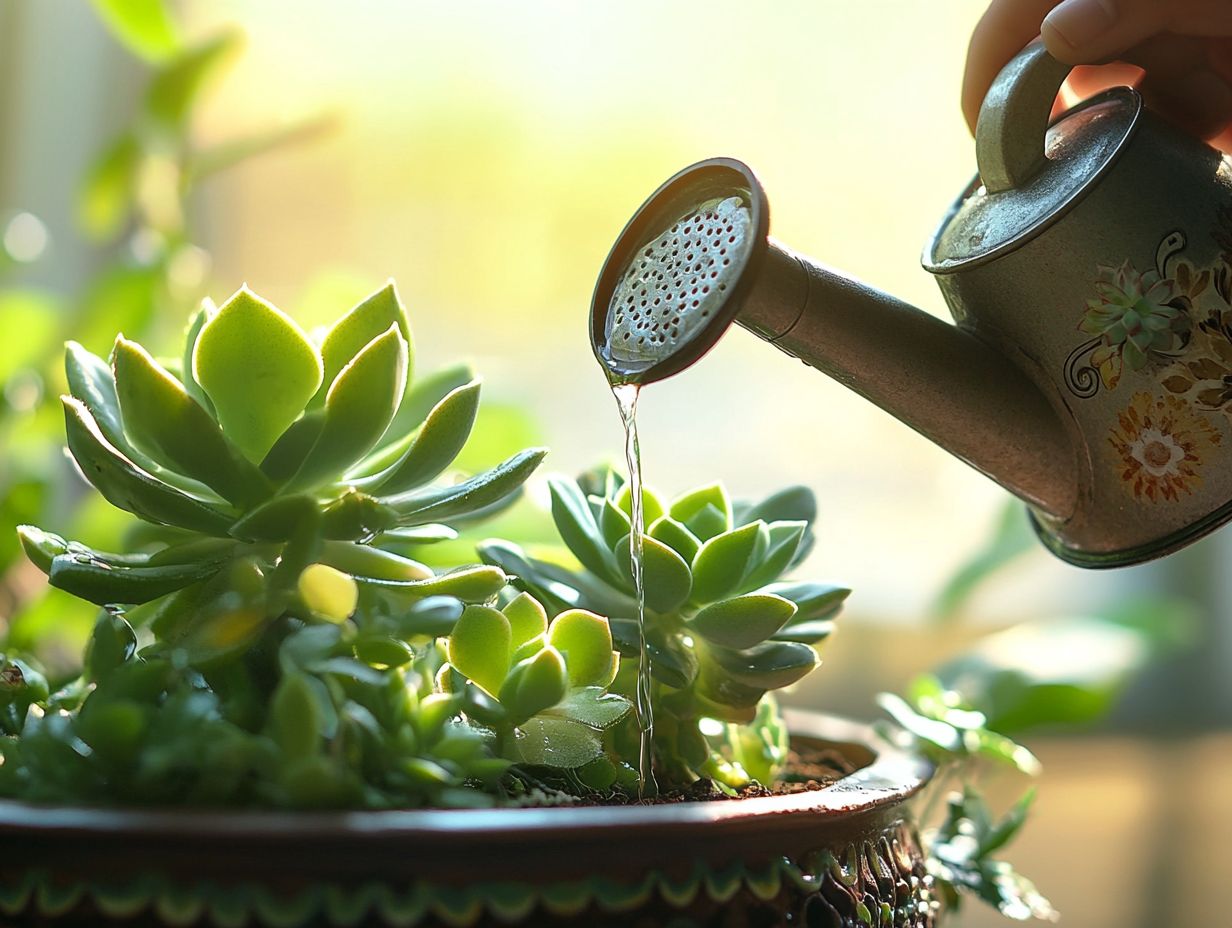
- Master the unique traits of succulents now for healthier plants.
- Signs of under and over-watering include wilting, yellowing, and rot.
- Succulents generally require infrequent watering, with the frequency depending on factors such as temperature, humidity, and the type of container they are in.
Understanding Succulents and Their Water Needs
Succulents are fascinating plants that flourish in various environments, each showcasing distinct characteristics that determine their water needs. Grasping the essential elements of these remarkable plants such as their soil requirements, ideal moisture levels, and growth patterns is crucial for nurturing their well-being.
You should pay close attention to factors like drainage holes in pots and how often you water them, as well as the specific conditions that enable different types of succulents, like cacti and aloe vera, to thrive.
By mastering their water requirements, you can create vibrant indoor and outdoor succulent gardens that truly flourish.
Characteristics of Succulents
Succulents stand out with their thick, fleshy leaves that act as reservoirs, allowing them to thrive in arid environments. These extraordinary plants showcase a range of adaptations that enable them to flourish where water is in short supply.
Many succulents show unique growth patterns, like rosettes or trailing vines. These not only enhance their visual appeal but also optimize sunlight exposure while minimizing water loss.
Additionally, their remarkable ability to store significant amounts of water in specialized tissues ensures they continue to thrive even during extended dry spells, showcasing their resilience and efficiency.
Water Requirements for Different Types of Succulents
Different types of succulents, like cacti, kalanchoe, and aloe vera, have unique water requirements shaped by their native environments and growth habits.
Cacti, which thrive in arid deserts, are the minimalist water users of the plant world, often needing hydration only every few weeks. In contrast, kalanchoe, native to tropical regions, enjoy a bit more moisture but need to avoid waterlogged conditions. Aloe vera, with its plump leaves designed to store moisture, is quite adaptable and can handle drought periods, typically asking for water every two to three weeks.
Understanding these native conditions is essential, as it helps determine the ideal watering frequency for each succulent. This respect for their unique moisture absorption abilities will foster lush growth and vibrant health in your collection.
Signs of Under and Over-Watering Succulents
Recognizing the signs of under and over-watering is essential for maintaining your succulents‘ health. Improper watering can have detrimental effects on their leaves and roots.
Succulents display specific symptoms that indicate either a lack of moisture or an excess of water, both of which can significantly hinder their growth and overall well-being. By paying close attention to these signals, you can fine-tune your care routines to cater to your succulents’ needs, ensuring that these resilient plants flourish in their chosen environments, whether inside your home or out in the garden.
Share your succulent care experiences with others to inspire more plant lovers!
How to Identify Signs of Under-Watering

Identifying the signs of under-watering in your succulents requires keen observation of their leaves and soil conditions. Look out for unmistakable indicators of lack of water.
You may notice shriveled leaves that seem lifeless or have a wrinkled texture. These are clear signs that they ve lost moisture.
The soil may feel parched to your touch, lacking the typical slight dampness that healthy succulents need. A drooping appearance throughout the plant can also be telling; it may look somewhat sad and less vibrant than its well-hydrated companions.
Together, these signs highlight the urgent need for water. They also serve as a warning of potential long-term damage if the situation continues.
Ignoring these clues could lead to severe dehydration stress and, ultimately, the demise of the plant.
How to Identify Signs of Over-Watering
Over-watering shows clear signs in your succulents’ leaves and roots. If you notice yellow or brown leaves, it s a sign they re stressed.
The stems might feel mushy, indicating too much moisture. In severe cases, roots can rot, which is when they decay due to excess water.
Recognizing these symptoms quickly helps you keep your succulents thriving! By ensuring adequate drainage and carefully managing your watering schedules, you can foster a healthier and more resilient garden.
Tips for Watering Succulents Correctly
Properly watering succulents is vital for their health and longevity. Here are several tips to ensure they receive just the right amount of moisture.
Understanding the unique watering needs of different succulent types is crucial. Also, recognizing the importance of drainage holes in your pots can significantly enhance their growth.
By tracking your watering frequency and adjusting care based on environmental conditions, you create an optimal environment that supports healthy plants, whether indoors or outdoors.
Best Practices for Watering Succulents
Employing best practices for watering succulents ensures you provide just the right amount of moisture. This helps you avoid the perils of over or under-watering.
A crucial strategy involves using well-draining soil. This prevents water from pooling and allows the roots to breathe freely.
Letting the soil dry out completely between waterings is essential. This mimics the natural conditions where succulents thrive.
Regularly monitoring moisture levels is also beneficial. A moisture meter can offer precise insights into when these distinctive plants are ready for a drink.
By adhering to these effective watering strategies, you can easily cultivate healthy, vibrant growth while avoiding common pitfalls.
How Often to Water Succulents
Determining how often you should water your succulents hinges on various factors, including your environment, the season, and the moisture levels in the soil.
Climate plays a crucial role in how frequently you need to water. Warmer temperatures and higher humidity can lead to quicker evaporation of water.
If your succulents are indoors, they might require less frequent watering thanks to controlled temperatures and stable humidity. On the other hand, succulents in outdoor gardens may need more regular attention, particularly during hot, dry spells.
It’s also vital to recognize seasonal changes. Succulents usually enter a dormant phase in the cooler months, which significantly reduces their water needs.
By understanding the local environmental factors, you can enhance the overall health and longevity of these resilient plants.
Watering Techniques for Different Types of Containers
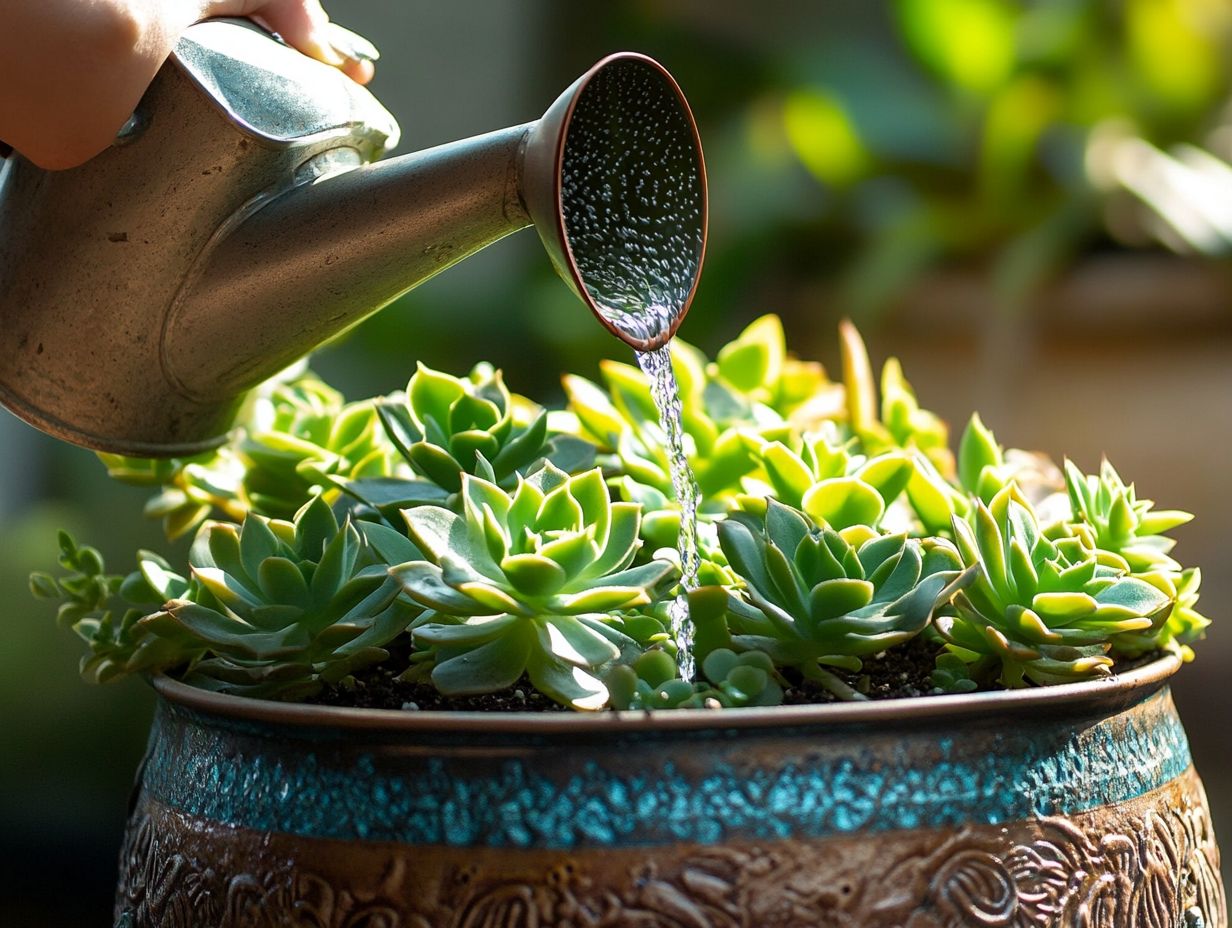
In terms of watering succulents, your approach should be tailored to the type of container you’re using whether it’s a pot or if you’ve planted them directly in the ground.
Each technique demands thoughtful attention to both drainage and moisture retention to ensure your plants thrive.
How to Water Succulents in Pots
Watering succulents in pots demands specific techniques to strike the perfect balance of moisture without letting water pool at the bottom. These remarkable plants, adapted to thrive in arid conditions, truly flourish when they experience proper drainage that mimics their natural habitat.
Choose pots made of terracotta or ceramic. These materials are beneficial. Their porous nature aids in moisture regulation and encourages evaporation. Always ensure that your chosen containers come equipped with drainage holes, allowing excess water to escape effortlessly.
When it’s time to water, consider employing a method such as bottom watering or gently pouring around the base of the plant. This approach guarantees that the soil becomes evenly saturated without becoming overly drenched. For more detailed techniques, you can refer to this guide on how to water your indoor garden correctly. Inspecting for signs of overwatering is crucial to maintaining the health and vitality of your resilient succulents.
How to Water Succulents in the Ground
Watering succulents planted in the ground requires distinct techniques compared to those in pots, emphasizing soil quality and moisture retention.
To ensure these resilient plants flourish, it s vital to pay attention to the soil composition. Ideally, you want a well-draining mix that allows excess water to escape effortlessly. This often includes a blend of sandy or gritty soil, which helps prevent root rot a condition where the roots of the plant decay due to excess moisture. Monitor the drainage capabilities of your garden bed to ensure water doesn t pool around those delicate roots.
Adjusting your watering schedule is crucial, especially after a rainfall. You ll want to reduce the frequency and deepen the soak to promote deeper root growth. During high-temperature periods, be mindful that your succulents may need a bit more hydration to thrive.
By understanding these elements, you ll achieve a balanced approach, fostering the long-term health and vitality of your succulents.
Other Factors to Consider
When caring for your succulents, don’t overlook crucial factors like temperature, humidity, and seasonal changes they can make or break your succulent’s health.
Embrace the nuances of their environment, and you’ll cultivate thriving greenery that reflects your attentive care.
Temperature and Humidity
Temperature and humidity play a vital role in determining how you care for and water your succulents. Each variety has distinct needs that stem from its native habitat.
For example, many popular types like Echeveria and Haworthia thrive in temperatures between 60 F and 80 F, perfectly reflecting their desert origins. On the other hand, some species, such as the Jade plant, can handle slightly cooler temperatures, while others might crave a bit more warmth.
Humidity levels also deserve your attention; most succulents prefer dry air, as elevated humidity can lead to unwelcome issues like root rot and mold. In fact, understanding the environment your plants thrive in is essential for their care.
By grasping these environmental preferences, you can fine-tune your watering schedule, striking the right balance that encourages vibrant growth and enhances longevity.
Ready to transform your garden into a succulent paradise? Start watering wisely today!
Seasonal Changes
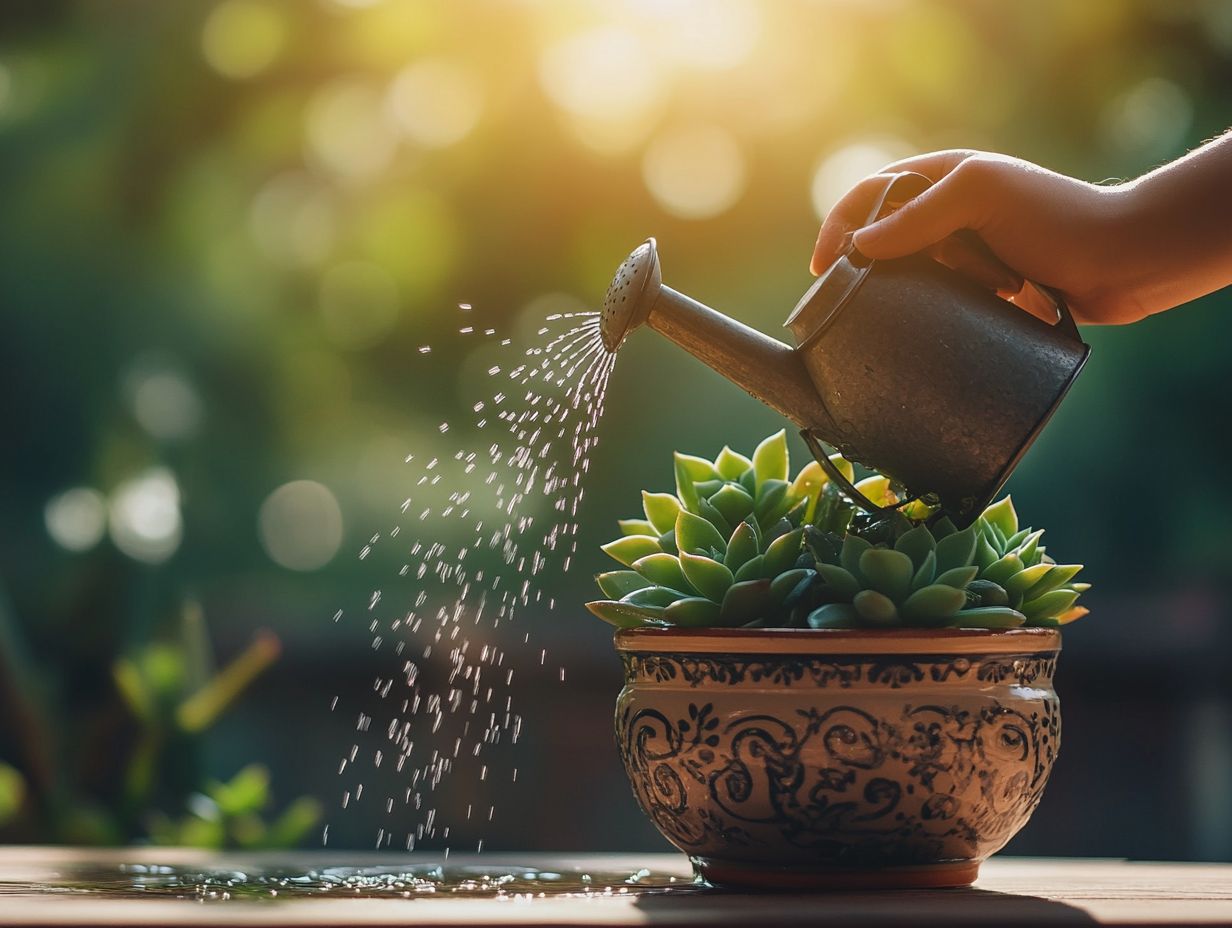
Seasonal changes play a pivotal role in determining how much care and water your succulents require, as these plants often need varying levels of water throughout the year.
During the warmer months, when temperatures climb and daylight stretches, your resilient succulents will typically demand more frequent watering to thrive. As the cooler seasons arrive, you might face increased rainfall, so stay alert! This can saturate the soil, putting your plants at risk of root rot if you’re not vigilant.
To navigate these seasonal shifts effectively, it’s essential to adjust your watering frequency and pay attention to factors like humidity and temperature fluctuations. Using a well-draining soil mix soil that allows water to escape easily, helping prevent root rot can be a game-changer during rainy periods. Adopting a routine of less frequent watering during dry spells will keep your hardy succulents healthy and vibrant all year round.
Frequently Asked Questions
How often should I water my succulents?
Succulents should be watered when the top inch of soil is completely dry. This can range from once a week to once every two weeks, depending on the climate and type of succulent.
How much water should I give my succulents?
It is important to give your succulents a thorough watering, ensuring the soil is completely saturated. However, avoid overwatering, as this can lead to root rot.
Can I use tap water to water my succulents?
It is recommended to use filtered or distilled water for succulents, as tap water may contain minerals and chemicals that can harm them. If you have no other option, let tap water sit out for 24 hours to allow the chemicals to evaporate.
Is it better to water my succulents from the top or the bottom?
It is best to water succulents from the bottom. Place the pot in a shallow dish of water and allow the soil to soak it up. This prevents water from getting on the leaves and potentially causing damage.
How do I know if I am watering my succulents correctly?
You can tell if you are watering your succulents correctly by checking the soil moisture level and the appearance of the leaves. If the soil is dry and the leaves are shriveled, it may need more water. If the leaves are mushy or yellow, you may be watering too much.
Should I water my succulents during their dormant period?
No, succulents do not need to be watered during their dormant period, usually during the winter months when they are not actively growing. Wait until new growth appears before resuming regular watering.
Take care of your succulents, and they ll reward you with vibrant growth!


